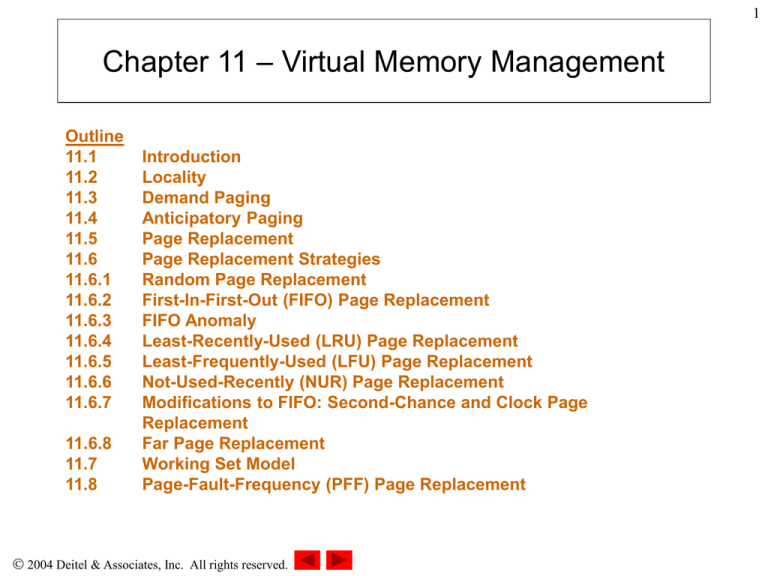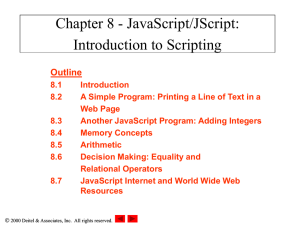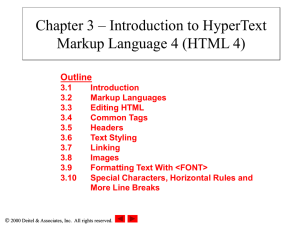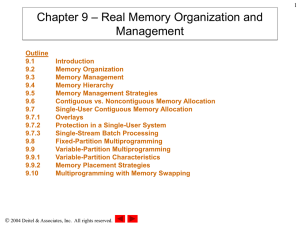
1
Chapter 11 – Virtual Memory Management
Outline
11.1
11.2
11.3
11.4
11.5
11.6
11.6.1
11.6.2
11.6.3
11.6.4
11.6.5
11.6.6
11.6.7
11.6.8
11.7
11.8
Introduction
Locality
Demand Paging
Anticipatory Paging
Page Replacement
Page Replacement Strategies
Random Page Replacement
First-In-First-Out (FIFO) Page Replacement
FIFO Anomaly
Least-Recently-Used (LRU) Page Replacement
Least-Frequently-Used (LFU) Page Replacement
Not-Used-Recently (NUR) Page Replacement
Modifications to FIFO: Second-Chance and Clock Page
Replacement
Far Page Replacement
Working Set Model
Page-Fault-Frequency (PFF) Page Replacement
2004 Deitel & Associates, Inc. All rights reserved.
2
Chapter 11 – Virtual Memory Management
Outline (continued)
11.9
Page Release
11.10
Page Size
11.11
Program Behavior under Paging
11.12
Global vs. Local Page Replacement
11.13
Case Study: Linux Page Replacement
2004 Deitel & Associates, Inc. All rights reserved.
3
Objectives
• After reading this chapter, you should understand:
– the benefits and drawbacks of demand and anticipatory paging.
– the challenges of page replacement.
– several popular page-replacement strategies and how they
compare to optimal page replacement.
– the impact of page size on virtual memory performance.
– program behavior under paging.
2004 Deitel & Associates, Inc. All rights reserved.
4
11.1 Introduction
• Replacement strategy
– Technique a system employs to select pages for replacement
when memory is full
– Determines where in main memory to place an incoming page or
segment
• Fetch strategy
– Determines when pages or segments should be loaded into main
memory
– Anticipatory fetch strategies
• Use heuristics to predict which pages a process will soon reference
and load those pages or segments
2004 Deitel & Associates, Inc. All rights reserved.
5
11.2 Locality
• Process tends to reference memory in highly localized
patterns
– In paging systems, processes tend to favor certain subsets of
their pages, and these pages tend to be adjacent to one another in
process’s virtual address space
2004 Deitel & Associates, Inc. All rights reserved.
6
11.3 Demand Paging
• Demand paging
– When a process first executes, the system loads into main
memory the page that contains its first instruction
– After that, the system loads a page from secondary storage to
main memory only when the process explicitly references that
page
– Requires a process to accumulate pages one at a time
2004 Deitel & Associates, Inc. All rights reserved.
7
11.3 Demand Paging
Figure 11.1 Space-time product under demand paging.
2004 Deitel & Associates, Inc. All rights reserved.
8
11.4 Anticipatory Paging
• Anticipatory paging
– Operating system attempts to predict the pages a process will
need and preloads these pages when memory space is available
– Anticipatory paging strategies
• Must be carefully designed so that overhead incurred by the
strategy does not reduce system performance
2004 Deitel & Associates, Inc. All rights reserved.
9
11.5 Page Replacement
• When a process generates a page fault, the memory
manager must locate referenced page in secondary
storage, load it into page frame in main memory and
update corresponding page table entry
• Modified (dirty) bit
– Set to 1 if page has been modified; 0 otherwise
– Help systems quickly determine which pages have been
modified
• Optimal page replacement strategy (OPT or MIN)
– Obtains optimal performance, replaces the page that will not be
referenced again until furthest into the future
2004 Deitel & Associates, Inc. All rights reserved.
10
10.6 Page-Replacement Strategies
• A page-replacement strategy is characterized by
– Heuristic it uses to select a page for replacement
– The overhead it incurs
2004 Deitel & Associates, Inc. All rights reserved.
11
10.6.1 Random Page Replacement
• Random page replacement
– Low-overhead page-replacement strategy that does not
discriminate against particular processes
– Each page in main memory has an equal likelihood of being
selected for replacement
– Could easily select as the next page to replace the page that will
be referenced next
2004 Deitel & Associates, Inc. All rights reserved.
12
10.6.2 First-In-First-Out (FIFO) Page Replacement
• FIFO page replacement
–
–
–
–
Replace page that has been in the system the longest
Likely to replace heavily used pages
Can be implemented with relatively low overhead
Impractical for most systems
2004 Deitel & Associates, Inc. All rights reserved.
13
11.6.2 First-In-First-Out (FIFO) Page Replacement
Figure 11.2 First-in-first-out (FIFO) page replacement.
2004 Deitel & Associates, Inc. All rights reserved.
14
11.6.3 FIFO Anomaly
• Belady’s (or FIFO) Anomoly
– Certain page reference patterns actually cause more page faults
when number of page frames allocated to a process is increased
2004 Deitel & Associates, Inc. All rights reserved.
15
11.6.3 FIFO Anomaly
Figure 11.3 FIFO anomaly–page faults can increase with page frame allocation.
2004 Deitel & Associates, Inc. All rights reserved.
16
11.6.4 Least-Recently-Used (LRU) Page Replacement
• LRU page replacement
– Exploits temporal locality by replacing the page that has spent
the longest time in memory without being referenced
– Can provide better performance than FIFO
– Increased system overhead
– LRU can perform poorly if the least-recently used page is the
next page to be referenced by a program that is iterating inside a
loop that references several pages
2004 Deitel & Associates, Inc. All rights reserved.
17
11.6.4 Least-Recently-Used (LRU) Page Replacement
Figure 11.4 Least-recently-used (LRU) page-replacement strategy.
2004 Deitel & Associates, Inc. All rights reserved.
18
11.6.5 Least-Frequently-Used (LFU) Page Replacement
• LFU page replacement
– Replaces page that is least intensively referenced
– Based on the heuristic that a page not referenced often is not
likely to be referenced in the future
– Could easily select wrong page for replacement
• A page that was referenced heavily in the past may never be
referenced again, but will stay in memory while newer, active
pages are replaced
2004 Deitel & Associates, Inc. All rights reserved.
19
11.6.6 Not-Used-Recently (NUR) Page Replacement
• NUR page replacement
– Approximates LRU with little overhead by using referenced bit
and modified bit to determine which page has not been used
recently and can be replaced quickly
– Can be implemented on machines that lack hardware referenced
bit and/or modified bit
2004 Deitel & Associates, Inc. All rights reserved.
20
11.6.6 Not-Used-Recently (NUR) Page Replacement
Figure 11.5 Page types under NUR.
2004 Deitel & Associates, Inc. All rights reserved.
21
11.6.7 Modification to FIFO: Second-Chance and Clock
Page Replacement
• Second chance page replacement
– Examines referenced bit of the oldest page
• If it’s off
– The strategy selects that page for replacement
• If it’s on
– The strategy turns off the bit and moves the page to tail of
FIFO queue
– Ensures that active pages are the least likely to be replaced
• Clock page replacement
– Similar to second chance, but arranges the pages in circular list
instead of linear list
2004 Deitel & Associates, Inc. All rights reserved.
22
11.6.8 Far Page Replacement
• Far page replacement
– Creates an access graph that characterizes a process’s reference
patterns
– Replace the unreferenced page that is furthest away from any
referenced page in the access graph
– Performs at near-optimal levels
– Has not been implemented in real systems
• Access graph is complex to search and manage without hardware
support
2004 Deitel & Associates, Inc. All rights reserved.
23
11.6.8 Far Page Replacement
Figure 11.6 Far page-replacement-strategy access graph.
2004 Deitel & Associates, Inc. All rights reserved.
24
11.7 Working Set Model
• For a program to run efficiently
– The system must maintain that program’s favored subset of
pages in main memory
• Otherwise
– The system might experience excessive paging activity causing
low processor utilization called thrashing as the program
repeatedly requests pages from secondary storage
2004 Deitel & Associates, Inc. All rights reserved.
25
11.7 Working Set Model
Figure 11.7 Storage reference pattern exhibiting locality. (Reprinted by permission
from IBM Systems Journal. © 1971 by International Business Machines Corporation.)
2004 Deitel & Associates, Inc. All rights reserved.
26
11.7 Working Set Model
• Because processes exhibit locality, increasing the
number of page frames allocated to a process has
little or no effect on its page fault rate at a certain
threshold
2004 Deitel & Associates, Inc. All rights reserved.
27
11.7 Working Set Model
Figure 11.8 Dependence of page fault rate on amount of memory for a process’s pages.
2004 Deitel & Associates, Inc. All rights reserved.
28
11.7 Working Set Model
• The process’s working set of pages, W(t, w), is the set
of pages referenced by the process during the
process-time interval t – w to t.
2004 Deitel & Associates, Inc. All rights reserved.
29
11.7 Working Set Model
Figure 11.9 Definition of a process’s working set of pages.
2004 Deitel & Associates, Inc. All rights reserved.
30
11.7 Working Set Model
• The size of the process’s working set increases
asymptotically to the process’s program size as its
working set window increases
2004 Deitel & Associates, Inc. All rights reserved.
31
11.7 Working Set Model
Figure 11.10 Working set size as a function of window size.
2004 Deitel & Associates, Inc. All rights reserved.
32
11.7 Working Set Model
• As a process transitions between working sets, the
system temporarily maintains in memory pages that
are no longer in the process’s current working set
– Goal of working set memory management is to reduce this
misallocation
2004 Deitel & Associates, Inc. All rights reserved.
33
11.7 Working Set Model
Figure 11.11 Main memory allocation under working set memory management.
2004 Deitel & Associates, Inc. All rights reserved.
34
11.8 Page-Fault-Frequency (PFF) Page Replacement
• Adjusts a process’s resident page set
– Based on frequency at which the process is faulting
– Based on time between page faults, called the process’s interfault
time
• Advantage of PFF over working set page replacement
– Lower overhead
• PFF adjusts resident page set only after each page fault
• Working set mechanism must operate after each memory reference
2004 Deitel & Associates, Inc. All rights reserved.
35
11.9 Page Release
• Inactive pages can remain in main memory for a long
time until the management strategy detects that the
process no longer needs them
– One way to solve the problem
• Process issues a voluntary page release to free a page frame that it
knows it no longer needs
• Eliminate the delay period caused by letting process gradually pass
the page from its working set
• The real hope is in compiler and operating system support
2004 Deitel & Associates, Inc. All rights reserved.
36
11.10 Page Size
• Some systems improve performance and memory utilization
by providing multiple page sizes
– Small page sizes
• Reduce internal fragmentation
• Can reduce the amount of memory required to contain a process’s working
set
• More memory available to other processes
– Large page size
• Reduce wasted memory from table fragmentation
• Enable each TLB entry to map larger region of memory, improving
performance
• Reduce number of I/O operations the system performs to load a process’s
working set into memory
– Multiple page size
• Possibility of external fragmentation
2004 Deitel & Associates, Inc. All rights reserved.
37
11.10 Page Size
Figure 11.12 Internal fragmentation in a paged and segmented system.
2004 Deitel & Associates, Inc. All rights reserved.
38
11.10 Page Size
Figure 11.13 Page sizes in various processor architectures.
2004 Deitel & Associates, Inc. All rights reserved.
39
11.11 Program Behavior under Paging
• Processes tend to reference a significant portion of
their pages within a short time after execution begins
• They access most of their remaining pages at a slower
rate
2004 Deitel & Associates, Inc. All rights reserved.
40
11.11 Program Behavior under Paging
Figure 11.14 Percentage of a process’s pages referenced with time.
2004 Deitel & Associates, Inc. All rights reserved.
41
11.11 Program Behavior under Paging
• Average interfault time monotonically increases in
general
– The more page frames a process has, the longer the time between
page faults
2004 Deitel & Associates, Inc. All rights reserved.
42
11.11 Program Behavior under Paging
Figure 11.15 Dependency of interfault time on the number of page frames allocated
to a process.
2004 Deitel & Associates, Inc. All rights reserved.
43
11.12 Global vs. Local Page Replacement
• Implementing a paged virtual memory system
– Global page-replacement strategies: applied to all processes as a
unit
• Tend to ignore characteristics of individual process behavior
• Global LRU (gLRU) page-replacement strategy
– Replaces the least-recently-used page in entire system
• SEQ (sequence) global page-replacement strategy
– Uses LRU strategy to replace pages until sequence of page
faults to contiguous pages is detected, at which point it uses
most-recently-used (MRU) page-replacement strategy
– Local page-replacement strategies: Consider each process
individually
• Enables system to adjust memory allocation according to relative
importance of each process to improve performance
2004 Deitel & Associates, Inc. All rights reserved.
44
11.13 Case Study: Linux Page Replacement
• Linux uses a variation of the clock algorithm to
approximate an LRU page-replacement strategy
• The memory manager uses two linked lists
– Active list
• Contains active pages
• Most-recently used pages are near head of active list
– Inactive list
• Contains inactive pages
• Least-recently used pages near tail of inactive list
– Only pages in the inactive list are replaced
2004 Deitel & Associates, Inc. All rights reserved.
45
11.13 Case Study: Linux Page Replacement
Figure 11.16 Linux page replacement overview.
2004 Deitel & Associates, Inc. All rights reserved.







